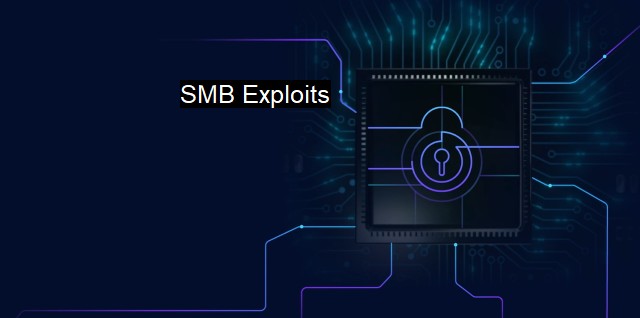What are SMB Exploits?
The Menace of SMB Exploits: Vulnerabilities, Methods and Mitigation
Server Message Block or SMB is a protocol predominantly used by Windows operating systems, which enables systems within the same network to share files. It is also used by other operating systems like Linux through SAMBA. Over the years, this protocol has been a target for numerous exploits, commonly referred to as SMB exploits. These are techniques or methods used by cybercriminals to take advantage of vulnerabilities in the SMB protocol to launch malicious attacks.One of the key SMB exploits includes the EternalBlue exploit. It gained worldwide prominence due to its utilization by the malicious WannaCry ransomware in 2017, leading to one of the biggest cybersecurity incident of the year. EternalBlue takes advantage of a vulnerability, named CVE-2017-0144, in Microsoft’s implementation of the SMB protocol. This vulnerability allows an attacker to execute arbitrary code on the target SMB server.
The main concern for SMB exploits is that they can stealthily self-propagate across networks, particularly those with weak security measures in place. As an example, malware like WannaCry and NotPetya have the capacity to worm their way across systems once the SMB vulnerability is exploited. This can result in large-scale compromises for businesses, causing substantial data loss, financial harm and potential regulatory implications due to data breaches.
Another significant SMB exploit is SMBGhost. This exploit, assigned CVE-2020-0796, impacts Windows 10 and several versions of Windows Server. It's known as a 'wormable' vulnerability, which means that cyberattacks can use it as a point of entry to create an infectious malware that attempts to transmit itself to potential victims around them. By sending a specially crafted packet to a targeted SMBv3 server, attackers could potentially exploit this vulnerability to execute arbitrary code on the targeted system.
Dealing with SMB exploits is a critical matter involving frequent attention, regular system updates and predominantly, a strong cybersecurity framework. Businesses are often advised to keep their systems updated with latest security patches released by vendors. Microsoft often releases security patches addressing the known SMB vulnerabilities, thereby ensuring systems are safeguarded against potential attacks.
The role of antivirus software in addressing SMB threats cannot be overlooked. A reliable and credible antivirus solution can be instrumental in identifying and blocking known malware that leverage these exploits. In many cases, an antivirus. program would conduct routine scans, identify malicious network activity, and block connections that originate from suspicious IP addresses, hence limiting the spread of exploits.
Companies are also encouraged to consider advanced proactive cybersecurity measures such as intrusion detection and prevention systems (IDS/IPS). These systems have the capacity to monitor networks, detect when an SMB attack is attempted, and prevent the attackers from achieving their goal.
Apart from these technical measures, fostering a culture of cybersecurity awareness in the corporate environment can also mitigate risks associated with SMB exploits. Regular employee training and a comprehensive awareness about typical cybersecurity threats, including how to avoid them, plays a crucial role in overall corporate network security. Employees, being frequent targets for cyberattacks, should be educated about the safe procedures to share files and sensitized about the hazards related to clicking on suspicious links or opening unexpected email attachments. unnecessary exposure of SMB ports (such as 445) should be minimized due to the association of these ports with higher risks of cyberattacks.
While SMB exploits emerged as significant cybersecurity threats, with a comprehensive and multi-layered cybersecurity strategy, businesses can effectively neutralize these dangers. Such a strategy would generally include continuous patching and updates, proactive monitoring via IDS/IPS systems, using a reputable antivirus solution, reinforcing a strong cybersecurity culture, and most importantly, limiting the exposure to unnecessary risk factors.

SMB Exploits FAQs
What are SMB exploits and why are they a threat to cybersecurity?
SMB exploits are a type of vulnerability that attackers can use to exploit weaknesses in the SMB protocol to gain unauthorized access to a network or system. SMB exploits can be extremely dangerous as they can allow attackers to steal sensitive information, execute malware, and launch attacks against other systems.How can antivirus software help protect against SMB exploits?
Antivirus software can help protect against SMB exploits by detecting and blocking known vulnerabilities and suspicious behavior associated with SMB traffic. By monitoring network traffic for signs of SMB exploits, antivirus software can help prevent attacks before they can do any harm.What are some common SMB exploits that organizations should be aware of?
Some common SMB exploits include EternalBlue, EternalRomance, and SMBGhost, among others. These exploits can allow attackers to take control of a target system, steal data, and spread malware throughout a network. Organizations should stay up-to-date on the latest threats and vulnerabilities associated with SMB traffic in order to protect against these types of attacks.What steps should organizations take to mitigate the risk of SMB exploits?
To mitigate the risk of SMB exploits, organizations should ensure that their antivirus software is up-to-date and configured to monitor SMB traffic for suspicious activity. Additionally, organizations should regularly patch and update their systems and software to address known vulnerabilities. Finally, organizations should consider implementing network segmentation and least privilege access controls to limit the impact of successful attacks.| | A | | | B | | | C | | | D | | | E | | | F | | | G | | | H | | | I | | | J | | | K | | | L | | | M | |
| | N | | | O | | | P | | | Q | | | R | | | S | | | T | | | U | | | V | | | W | | | X | | | Y | | | Z | |
| | 1 | | | 2 | | | 3 | | | 4 | | | 7 | | | 8 | | |||||||